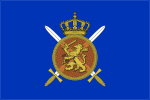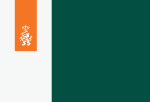| Royal Netherlands Army | |
|---|---|
| Koninklijke Landmacht | |
 Emblem of the Royal Netherlands Army | |
| Founded | 9 January 1814 |
| Country | |
| Type | Army |
| Role | Land warfare |
| Size |
|
| Part of | Netherlands Armed Forces |
| Headquarters | Kromhoutkazerne, Utrecht |
| Engagements | List of engagements
|
| Commanders | |
| Commander | Lt Gen Martin Wijnen[3] |
| Deputy commander | Maj Gen Rob Jeulink |
| Army Adjutant | WO Ad Koevoets[4] |
| Insignia | |
| Flag |  |
| Flag used on government buildings |  |
| Logo |  |
The Royal Netherlands Army (Dutch: Koninklijke Landmacht, KL) is the land branch of the Netherlands Armed Forces. Though the Royal Netherlands Army was raised on 9 January 1814, its origins date back to 1572, when the Staatse Leger was raised making the Dutch standing army one of the oldest in the world. It fought in the Napoleonic Wars, World War II, the Indonesian War of Independence and the Korean War, as well as served with NATO on the Cold War frontiers in West Germany from the 1950s to the 1990s.[5]
Since 1990, the army has been sent into the Iraq War (from 2003) and into the War in Afghanistan, as well as deployed in several United Nations' peacekeeping missions (notably with UNIFIL in Lebanon, UNPROFOR in Bosnia-Herzegovina and MINUSMA in Mali).[6]
The tasks of the Royal Netherlands Army are laid out in the Constitution of the Netherlands: defend the territory of the Kingdom of the Netherlands (including the Dutch Caribbean) and all of its allies, protect and advance the international legal order and to support the (local) government in law enforcement, disaster relief and humanitarian aid, both nationally and internationally.[7] The supreme authority over the Armed Forces of the Netherlands is exercised by the government (consisting of the King and the cabinet ministers); there is thus no constitutional supreme commander. However, army personnel do swear allegiance to the Dutch monarch.[8]
Dutch army doctrine strongly emphasises international co-operation.[9] The Netherlands are a founding member of, and strong contributor to NATO, while closely co-operating with fellow member states during European Union-led missions as well. Moreover, the successful Dutch-German military co-operation is seen as a harbinger of European defence integration, facing fewer linguistic and cultural issues than the comparable Franco-German Brigade.[10] In 2014, the 11 Airmobile Brigade was integrated into the Rapid Forces Division;[11] in 2016, the Dutch-German 414 Tank Battalion was integrated into the 43rd Mechanised Brigade, which was in turn integrated into the 1st Panzer Division.[10][12] In 2023, the final brigade of the Royal Netherlands Army, the 13th Light Brigade, was integrated into the 10th Panzer Division of the German Bundeswehr.[13][14]
Additionally, the German Air Defence Missile Group 61 (German: Flugabwehrraketengruppe 61) was integrated into the Dutch Joint Ground-based Air Defence Command in 2018.[15]
- ^ "Personnel Figures". defensie.nl. Ministry of Defence. 1 September 2023. Retrieved 16 August 2024.
- ^ Defensie, Ministerie van (12 September 2017). "The Dutch contribution to the Gulf war - Historical missions - Defensie.nl". english.defensie.nl. Archived from the original on 1 October 2020. Retrieved 9 July 2024.
- ^ Kos, Jelmer (2 April 2019). "Martin Wijnen wordt nieuwe commandant landstrijdkrachten". NRC Handelsblad. Retrieved 16 May 2020.
- ^ van Elk, Bert (3 March 2020). "Ervaren korporaals stromen door: Onderofficiersbestand aan het Infuus". Landmacht. 02. Retrieved 16 May 2020.
- ^ Cite error: The named reference
landmachtwas invoked but never defined (see the help page). - ^ "Missie-overzicht". www.defensie.nl. Ministerie van Defensie. 28 August 2013. Retrieved 16 May 2020.
- ^ "Taken van de krijgsmacht". www.rijksoverheid.nl. Rijksoverheid. 23 April 2014. Retrieved 16 May 2020.
- ^ "11a. Integriteit". Algemeen militair ambtenarenreglement. Overheid.nl. 25 February 1982. Retrieved 16 May 2020.
Ik zweer trouw aan de Koning, gehoorzaamheid aan de wetten en onderwerping aan de krijgstucht. Zo waarlijk helpe mij God Almachtig
- ^ "Taken landmacht". www.defensie.nl. Ministerie van Defensie. 16 September 2019. Retrieved 16 May 2020.
- ^ a b Bennhold, Katrin (20 February 2019). "A European Army? The Germans and Dutch Take a Small Step". The New York Times. Retrieved 16 May 2020.
- ^ "Division Schnelle Kräfte". www.defensie.nl. Ministerie van Defensie. 12 December 2016. Retrieved 16 May 2020.
- ^ Hoffmann, Lars (8 August 2017). "German Armed Forces To Integrate Sea Battalion Into Dutch Navy". defensenews.com. Retrieved 1 October 2017.
- ^ Darroch, Gordon (1 February 2023). "Netherlands to integrate last brigade into German army this year: NRC". DutchNews.nl. Retrieved 28 March 2023.
- ^ NACHRICHTEN, n-tv. "Heer von Deutschland und Niederlanden nimmt Form an". n-tv.de (in German). Retrieved 28 March 2023.
- ^ "Duitse luchtverdedigingseenheid onder Nederlands bevel geplaatst". NU.nl. 4 April 2018. Retrieved 16 May 2020.